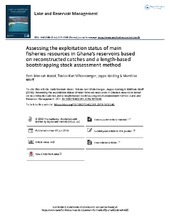| dc.contributor.author | Abobi, Seth Mensah | |
| dc.contributor.author | Mildenberger, Tobias Karl | |
| dc.contributor.author | Kolding, Jeppe | |
| dc.contributor.author | Wolff, Matthias | |
| dc.date.accessioned | 2020-06-24T13:04:40Z | |
| dc.date.available | 2020-06-24T13:04:40Z | |
| dc.date.issued | 2019 | |
| dc.Published | Abobi, Mildenberger, Kolding J, Wolff M. Assessing the exploitation status of main fisheries resources in Ghana’s reservoirs based on reconstructed catches and a length-based bootstrapping stock assessment method. Lake and reservoir management. 2019;35(4):415-434 | eng |
| dc.identifier.issn | 2151-5530 | en_US |
| dc.identifier.issn | 1040-2381 | en_US |
| dc.identifier.uri | https://hdl.handle.net/1956/22944 | |
| dc.description.abstract | Abobi SM, Mildenberger TK, Kolding J, Wolff M. 2019. Assessing the exploitation status of main fisheries resources in Ghana’s reservoirs based on reconstructed catches and a length-based bootstrapping stock assessment method. Lake Reserv Manage. 35:415–434. The cichlid species Oreochromis niloticus, Sarotherondon galilaeus, and Coptodon zillii, which are among the most exploited resources in the small-scale fisheries of the Tono, Bontanga, and Golinga reservoirs in northern Ghana, were assessed based on length frequency samples. Growth, mortality, exploitation status, stock size, and relative yield per recruit reference points were determined using bootstrapping fish stock assessment (BFSA), a novel framework that allows for the estimation of uncertainties around the life-history parameters and reference levels (e.g., L∞, K, and F0.1). The results suggest that the 3 species studied are heavily exploited in all 3 reservoirs, but with no alarming signs of overexploitation. The fishing effort at Golinga is comparatively low as a result of insignificant fishing during the agriculture season, which relates to low exploitation rates. Sarotherondon galilaeus and C. zillii have the highest and lowest biomass (t/km2) respectively in all the 3 reservoirs. The small shallow reservoir (Golinga) has the highest biomass of the target resources per unit area. According to a second assessment approach, based on length-based indicators, all species at Bontanga and O. niloticus and S. galilaeus populations at Golinga have spawning stock biomasses below 40% of the unfished biomass. This points to a situation of a possible ongoing recruitment overfishing of those species in the 2 reservoirs and suggests that a further increase in fishing effort should be prevented. Further monitoring of these fisheries will be needed for the improvement of assessments and thus management advice. | en_US |
| dc.language.iso | eng | eng |
| dc.publisher | Taylor & Francis | en_US |
| dc.rights | Attribution-NonCommercial-NoDerivs CC BY-NC-ND | eng |
| dc.rights.uri | http://creativecommons.org/licenses/by-nc-nd/4.0/ | eng |
| dc.title | Assessing the exploitation status of main fisheries resources in Ghana’s reservoirs based on reconstructed catches and a length-based bootstrapping stock assessment method | en_US |
| dc.type | Peer reviewed | |
| dc.type | Journal article | |
| dc.date.updated | 2020-01-02T12:17:52Z | |
| dc.description.version | publishedVersion | en_US |
| dc.rights.holder | Copyright 2019 The Author(s) | en_US |
| dc.identifier.doi | https://doi.org/10.1080/10402381.2019.1616340 | |
| dc.identifier.cristin | 1749220 | |
| dc.source.journal | Lake and reservoir management | |

